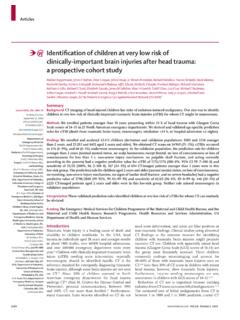Transcription of Identification of children at very low risk of clinically ...
1 Articles1160 Vol 374 October 3, 2009 Identifi cation of children at very low risk of clinically -important brain injuries after head trauma: a prospective cohort study Nathan Kuppermann, James F Holmes, Peter S Dayan, John D Hoyle, Jr, Shireen M Atabaki, Richard Holubkov, Frances M Nadel, David Monroe, Rachel M Stanley, Dominic A Borgialli, Mohamed K Badawy, Jeff E Schunk, Kimberly S Quayle, Prashant Mahajan, Richard Lichenstein, Kathleen A Lillis, Michael G Tunik, Elizabeth S Jacobs, James M Callahan, Marc H Gorelick, Todd F Glass, Lois K Lee, Michael C Bachman, Arthur Cooper, Elizabeth C Powell, Michael J Gerardi, Kraig A Melville, J Paul Muizelaar, David H Wisner, Sally Jo Zuspan, J Michael Dean, Sandra L Wootton-Gorges.
2 For the Pediatric Emergency Care Applied Research Network (PECARN)*SummaryBackground CT imaging of head-injured children has risks of radiation-induced malignancy. Our aim was to identify children at very low risk of clinically -important traumatic brain injuries (ciTBI) for whom CT might be We enrolled patients younger than 18 years presenting within 24 h of head trauma with Glasgow Coma Scale scores of 14 15 in 25 North American emergency departments. We derived and validated age-specifi c prediction rules for ciTBI (death from traumatic brain injury, neurosurgery, intubation >24 h, or hospital admission 2 nights).
3 Findings We enrolled and analysed 42 412 children (derivation and validation populations: 8502 and 2216 younger than 2 years, and 25 283 and 6411 aged 2 years and older). We obtained CT scans on 14 969 (35 3%); ciTBIs occurred in 376 (0 9%), and 60 (0 1%) underwent neurosurgery. In the validation population, the prediction rule for children younger than 2 years (normal mental status, no scalp haematoma except frontal, no loss of consciousness or loss of consciousness for less than 5 s, non-severe injury mechanism, no palpable skull fracture, and acting normally according to the parents) had a negative predictive value for ciTBI of 1176/1176 (100 0%, 95% CI 99 7 100 0) and sensitivity of 25/25 (100%, 86 3 100 0).
4 167 (24 1%) of 694 CT-imaged patients younger than 2 years were in this low-risk group. The prediction rule for children aged 2 years and older (normal mental status, no loss of consciousness, no vomiting, non-severe injury mechanism, no signs of basilar skull fracture, and no severe headache) had a negative predictive value of 3798/3800 (99 95%, 99 81 99 99) and sensitivity of 61/63 (96 8%, 89 0 99 6). 446 (20 1%) of 2223 CT-imaged patients aged 2 years and older were in this low-risk group. Neither rule missed neurosurgery in validation These validated prediction rules identifi ed children at very low risk of ciTBIs for whom CT can routinely be The Emergency Medical Services for children Programme of the Maternal and Child Health Bureau, and the Maternal and Child Health Bureau Research Programme, Health Resources and Services Administration, US Department of Health and Human Services.
5 IntroductionTraumatic brain injury is a leading cause of death and disability in children worldwide. In the USA, head trauma in individuals aged 18 years and younger results in about 7400 deaths, over 60 000 hospital admissions, and over 600 000 emergency department visits every ,2 children with clinically -important traumatic brain injury (ciTBI) needing acute intervention, especially neurosurgery, should be identifi ed rapidly. CT is the reference standard for emergently diagnosing traumatic brain injuries, although some brain injuries are not seen on ,4 About 50% of children assessed in North American emergency departments for head trauma undergo CT5,6 (Faul M, Centers for Disease Control and Prevention, personal communication).
6 Between 1995 and 2005, CT use more than ,7 Furthermore, many traumatic brain injuries identifi ed on CT do not need acute intervention, and some are false positives or non-traumatic fi ndings. Clinical studies using abnormal CT fi ndings as the outcome measure for identifying children with traumatic brain injuries might promote excessive CT use. children with apparently minor head trauma (Glasgow Coma Scale [GCS] scores of 14 15) are the group most frequently assessed. These children commonly undergo neuroimaging and account for 40 60% of those with traumatic brain injuries seen on 11 Less than 10% of CT scans in children with minor head trauma, however, show traumatic brain injuries.
7 Furthermore, injuries needing neurosurgery are very uncommon in children with GCS scores of 14 13 Reduction of CT use is important because ionising radiation from CT scans can cause lethal 16 The estimated rate of lethal malignancies from CT is between 1 in 1000 and 1 in 5000 paediatric cranial CT Lancet 2009; 374: 1160 70 Published OnlineSeptember 15, 2009 (09)61558-0 See Comment page 1127*Members listed at end of paperDepartments of Emergency Medicine (Prof N Kuppermann MD, Prof J F Holmes MD), Pediatrics (Prof N Kuppermann), Neurological Surgery (Prof J P Muizelaar MD), Surgery (Prof D H Wisner MD), and Radiology (Prof S L Wootton-Gorges MD), University of California, Davis School of Medicine, Davis, CA, USA; Department of Pediatrics, Columbia University College of Physicians and Surgeons, New York, NY, USA (P S Dayan MD).
8 Division of Emergency Medicine, Michigan State University School of Medicine/Helen DeVos children s Hosp, Grand Rapids, MI, USA (J D Hoyle MD); Departments of Pediatrics and Emergency Medicine, George Washington University School of Medicine, Washington, DC, USA (S M Atabaki MD); Department of Pediatrics, University of Utah (R Holubkov PhD, Prof J E Schunk MD, S J Zuspan RN, Prof J M Dean MD), and PECARN Central Data Management and Coordinating Center (R Holubkov, S J Zuspan, Prof J M Dean), Salt Lake City, UT, USA; Department of Pediatrics, University of Pennsylvania School of Medicine, Philadelphia, PA, USA (F M Nadel MD); Department of Emergency Medicine, Howard County General Hospital, Columbia, MD, USA (D Monroe MD); Vol 374 October 3, 2009 1161scans, with risk increasing as age ,15 Clear data for CT use, however, are unavailable, therefore resulting in substantial practice Previous predictive models8,10,18 20 are limited by small sample sizes, no validation, and/or no independent assessment of preverbal children (<2 years of age).
9 Therefore, creation and validation of accurate, generalisable prediction rules for identifying children at very low risk of ciTBI are needed. A systematic review21 of head CT prediction rules has recently emphasised the need for a large prospective study of children with minor head trauma to derive and validate a precise rule, and has specifi cally recommended deriving a separate rule for very young children . Our aim was to derive and validate prediction rules for ciTBI to identify children at very low risk of ciTBI after blunt head trauma for whom CT might be Patients and settingWe did a prospective cohort study of patients younger than 18 years with head trauma in 25 emergency departments of a paediatric research The study was approved by the Human Subjects Research Committee at each site with waiver of consent at some sites and verbal consent for telephone follow-up at others.
10 We enrolled the derivation population from June, 2004, to March, 2006, and the validation population from March through September, 2006. Department of Emergency Medicine, University of Michigan School of Medicine, Ann Arbor, MI, USA (R M Stanley MD); Department of Emergency Medicine, University of Michigan School of Medicine and Hurley Medical Center, Flint, MI, USA (D A Borgialli DO); Departments of Emergency Medicine and Pediatrics, University of Rochester School of Medicine and Dentistry, Rochester, NY, USA (M K Badawy MD); Department of Pediatrics, Washington University School of Medicine, St Louis, MO, USA (K S Quayle MD); Department of Pediatrics, Wayne State University School of Medicine, Detroit, MI, USA (P Mahajan MD).








